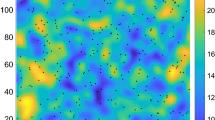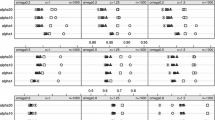Abstract
The incompleteness of data is a most common source of uncertainty in real-world Data Mining applications. The management of this uncertainty is, therefore, a task of paramount importance for the data analyst. Many methods have been developed for missing data imputation, but few of them approach the problem of imputation as part of a general data density estimation scheme. Amongst the latter, a method for imputing and visualizing multivariate missing data using Generative Topographic Mapping was recently presented. This model and some of its extensions are tested under different experimental conditions. Its performance is compared to that of other missing data imputation techniques, thus assessing its relative capabilities and limitations.
Preview
Unable to display preview. Download preview PDF.
Similar content being viewed by others
References
Olinsky, A., Chen, S., Harlow, L.: The Comparative Efficacy of Imputation Methods for Missing Data in Structural Equation Modelling. Eur. J. Oper. Res. 151, 53–79 (2003)
Troyanskaya, O., Cantor, M., Sherlock, G., Brown, P., Hastie, T., Tibshirani, R., Botstein, D., Altman, R.B.: Missing Value Estimation Methods for DNA Microarrays. Bioinformatics 17, 520–525 (2001)
Vicente, D., Vellido, A., Martí, E., Comas, J., Rodriguez-Roda, I.: Exploration of the Ecological Status of Mediterranean Rivers: Clustering, Visualizing and Reconstructing Streams Data Using Generative Topographic Mapping. In: Zanasi, A., Ebecken, N.F.F., Brebbia, C.A. (eds.) Data Mining V. W.I.T. Transactions on Information and Communication Technologies, vol. 30, pp. 121–130 (2004)
Cooke, M.P., Green, P.D., Josifovski, L., Vizinho, A.: Robust Automatic Speech Recognition with Missing and Unreliable Acoustic Data. Speech Commun. 34, 267–285 (2001)
Schafer, J.L.: Analysis of Incomplete Data. Chapman & Hall, London (1997)
Sun, Y., Tiňo, P., Nabney, I.: GTM-Based Data Visualization with Incomplete Data. Technical Report, NCRG, Aston University, UK (2001)
Olier, I., Vellido, A.: Assessing the Robustness of Missing Data Imputation Through Generative Topographic Mapping. ACIA Newsletter 31, 14–20 (2004)
Bishop, C.M., Svensén, M., Williams, C.K.I.: GTM: The Generative Topographic Mapping. Neural Comput. 10, 215–234 (1998)
Dempster, A.P., Laird, M.N., Rubin, D.B.: Maximum Likelihood from Incomplete Data Via the EM Algorithm. J. Roy. Statist. Soc. Ser. B 39, 1–38 (1977)
Kohonen, T.: Self-organizing Maps. Springer, Berlin (1995)
Bishop, C.M., Svensén, M., Williams, C.K.I.: Developments of the Generative Topographic Mapping. Neurocomputing 21, 203–224 (1998)
Vellido, A., El-Deredy, W., Lisboa, P.J.G.: Selective Smoothing of the Generative Topographic Mapping. IEEE Trans. Neural Networks 14, 847–852 (2003)
Mackay, D.J.C.: A Practical Bayesian Framework for Back-Propagation Networks. Neural Comput. 4, 448–472 (1992)
Carreira-Perpiñan, M.A.: Reconstruction of Sequential Data with Probabilistic Models and Continuity Constraints. In: Solla, S.A., Leen, T.K., Müller, K.-R. (eds.) Advances in Neural Information Processing Systems, vol. 12, pp. 414–420. MIT Press, Cambridge (2000)
Ghahramani, Z., Jordan, M.I.: Learning from Incomplete Data. Technical Report, AI Laboratory, MIT (1994)
Hunt, L., Jorgensen, M.: Mixture Model Clustering for Mixed Data with Missing Information. Comput. Statist. Data Anal. 41, 429–440 (2003)
Wang, H.X., Zhang, Q.B., Luo, B., Wei, S.: Robust Mixture Modelling Using Multivariate t-Distribution with Missing Information. Pattern Recognit. Lett. 25, 701–710 (2004)
Author information
Authors and Affiliations
Editor information
Editors and Affiliations
Rights and permissions
Copyright information
© 2005 Springer-Verlag Berlin Heidelberg
About this paper
Cite this paper
Olier, I., Vellido, A. (2005). Comparative Assessment of the Robustness of Missing Data Imputation Through Generative Topographic Mapping. In: Cabestany, J., Prieto, A., Sandoval, F. (eds) Computational Intelligence and Bioinspired Systems. IWANN 2005. Lecture Notes in Computer Science, vol 3512. Springer, Berlin, Heidelberg. https://doi.org/10.1007/11494669_96
Download citation
DOI: https://doi.org/10.1007/11494669_96
Publisher Name: Springer, Berlin, Heidelberg
Print ISBN: 978-3-540-26208-4
Online ISBN: 978-3-540-32106-4
eBook Packages: Computer ScienceComputer Science (R0)




